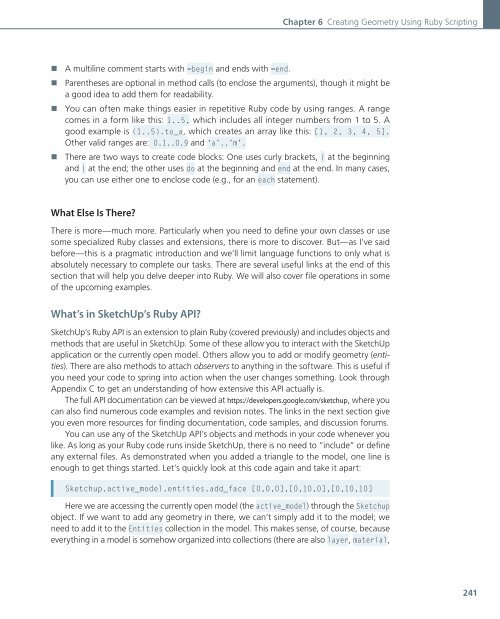Architectural_Design_with_SketchUp
Create successful ePaper yourself
Turn your PDF publications into a flip-book with our unique Google optimized e-Paper software.
Chapter 6 Creating Geometry Using Ruby Scripting<br />
NN<br />
NN<br />
NN<br />
NN<br />
A multiline comment starts <strong>with</strong> =begin and ends <strong>with</strong> =end.<br />
Parentheses are optional in method calls (to enclose the arguments), though it might be<br />
a good idea to add them for readability.<br />
You can often make things easier in repetitive Ruby code by using ranges. A range<br />
comes in a form like this: 1..5, which includes all integer numbers from 1 to 5. A<br />
good example is (1..5).to_a, which creates an array like this: [1, 2, 3, 4, 5].<br />
Other valid ranges are: 0.1..0.9 and ‘a’..’m’.<br />
There are two ways to create code blocks: One uses curly brackets, { at the beginning<br />
and } at the end; the other uses do at the beginning and end at the end. In many cases,<br />
you can use either one to enclose code (e.g., for an each statement).<br />
What Else Is There?<br />
There is more—much more. Particularly when you need to define your own classes or use<br />
some specialized Ruby classes and extensions, there is more to discover. But—as I’ve said<br />
before—this is a pragmatic introduction and we’ll limit language functions to only what is<br />
absolutely necessary to complete our tasks. There are several useful links at the end of this<br />
section that will help you delve deeper into Ruby. We will also cover file operations in some<br />
of the upcoming examples.<br />
What’s in <strong>SketchUp</strong>’s Ruby API?<br />
<strong>SketchUp</strong>’s Ruby API is an extension to plain Ruby (covered previously) and includes objects and<br />
methods that are useful in <strong>SketchUp</strong>. Some of these allow you to interact <strong>with</strong> the <strong>SketchUp</strong><br />
application or the currently open model. Others allow you to add or modify geometry (entities).<br />
There are also methods to attach observers to anything in the software. This is useful if<br />
you need your code to spring into action when the user changes something. Look through<br />
Appendix C to get an understanding of how extensive this API actually is.<br />
The full API documentation can be viewed at https://developers.google.com/sketchup, where you<br />
can also find numerous code examples and revision notes. The links in the next section give<br />
you even more resources for finding documentation, code samples, and discussion forums.<br />
You can use any of the <strong>SketchUp</strong> API’s objects and methods in your code whenever you<br />
like. As long as your Ruby code runs inside <strong>SketchUp</strong>, there is no need to “include” or define<br />
any external files. As demonstrated when you added a triangle to the model, one line is<br />
enough to get things started. Let’s quickly look at this code again and take it apart:<br />
Sketchup.active_model.entities.add_face [0,0,0],[0,10,0],[0,10,10]<br />
Here we are accessing the currently open model (the active_model) through the Sketchup<br />
object. If we want to add any geometry in there, we can’t simply add it to the model; we<br />
need to add it to the Entities collection in the model. This makes sense, of course, because<br />
everything in a model is somehow organized into collections (there are also layer, material,<br />
241

















